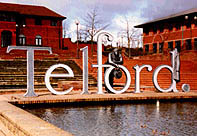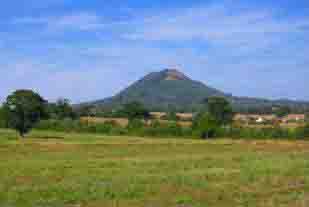Including the Unesco



|
Why Telford? Telford is a large new town in Shropshire created by merging smaller settlements such as Wellington, *Oakengates, Dawley and Madeley. Originally called Dawley New Town in 1968 the area was renamed Telford after renowned civil engineer Thomas Telford. With population predicted to grow to around 200,000 that will make it larger than cities such as York and Newcastle and Oxford today. |
*'Wombridge: Later Oakengates', A History of the County of Shropshire: Volume 11:
The Wrekin.
Telford is also home to The Wrekin, formed by volcanic activity millions of years ago and now one of Shropshire's iconic premier natural landmarks. 1335 ft above sea level. Wonderful views from the summit (Snowdonia on a really good day!) and over 15 counties, and is said to have been JRR Tolkeins inspiration for Middle Earth in his The Lord of the Rings books. There's a Shropshire legend that says it's actually a rock dropped by a careless giant!
Telford (1985), pp. 283-284. URL:
http://www.british-history.ac.uk/report.aspx?compid=18175 Date accessed:
16 April 2010.
Wombridge parish developed out of the demesnes of the Augustinian priory of St. Leonard, founded c. 1135 in a clearing in Hadley wood.
The area was the centre of one of the two bailiwicks of the royal forest of Mount Gilbert (or the Wrekin); like the centre of the other Haughmond, also a monastic site it was extraparochial. The priory stood less than 1 km. north of Watling Street, which bisected the ancient parish. The parish extended only to Oakengates, a late medieval hamlet on its eastern edge, and stood on Watling Street 4 km. east of Wellington.
Oakengates grew into a sizeable town in the mid 19th century, dwarfing the small settlement at Wombridge, and in 1895 Wombridge parish council tried, though unsuccessfully, to change the parish name to Oakengates. In 1898, however, Wombridge civil parish, conterminous with the ancient parish, was included in the new urban district of Oakengates,

Why Ironbridge?
Spectacular and beautiful, Ironbridge Gorge offers a unique chance to step back in time to an age when the pounding of steam hammers and the clatter of horse hooves was commonplace.
As you walk through the Gorge you are constantly reminded of the role that this area played at the beginning of the Industrial Revolution. Footprints of the past are everywhere. Sleeping furnaces and abandoned railway tracks are now mellowed by nature. In the Dale amongst the bird song, you can hear the constant gushing of water, not from a natural brook or waterfall but from the complex series of man-made watercourses that turned the enormous waterwheels and powered the foundries.
Today 10 amazing museums pay tribute to the proud history of the area, whilst a new breed of creative arts and industries have evolved within Gorge all adding to this unique offering available to visitors to Ironbridge & Shropshire of all ages.
![]() UNESCO World Heritage Site.
UNESCO World Heritage Site.
Sometimes known as the "Valley of Invention", the Ironbridge Gorge World Heritage Site is universally recognised for its unique role in the development of the Industrial Revolution that originated in Britain in the early years of the 18th century. Awarded World Heritage Site status by Unesco in 1986 as recognition of the area's unique contribution to the birth of the Industrial Revolution in the 18th century.
A number of significant factors combined to give rise to this, including, the abundant presence of the raw materials of production (coal, ironstone, clay and wood); rivers for power and transportation; and perhaps most significantly, entrepreneurs, innovators and engineers with vision, imagination and ambition. Names such as Abraham Darby, John Wilkinson, William Reynolds and Thomas Telford are inextricably linked with the history of this area, and the Ironbridge Gorge still contains much evidence of their work and influence in the buildings, structures, artefacts and settlement patterns that exist today.
The focal point of the Ironbridge Gorge is perhaps the Iron Bridge itself - the first bridge in the world to be constructed of iron. Built in 1779 to a design by Shrewsbury architect Thomas Farnolls Pritchard and cast at the Coalbrookdale ironworks of Abraham Darby III, the bridge soon became a tourist attraction, drawing people from many countries, including artists, engineers and entrepreneurs. The Iron Bridge remains a powerful icon of the Industrial Revolution recognised across the world.
Historically, the economy of the Ironbridge Gorge was based on the industries of mining, iron and ceramics. With the exception of the Coalbrookdale Works of the Aga-Rayburn company (a world-class, internationally known company producing cookers and stoves) and the recent re-introduction of tile making in Jackfield, the traditional industries have long since disappeared.
The distinctive landscape of the Ironbridge Gorge World Heritage Site is characterised by an unusual combination of remains of early industry and mining, land use patterns of agriculture and woodland management, and the survival and continued use of many historic industrial, commercial and residential buildings.
These are all set within a dramatic and attractive "natural-looking" valley landscape, with steep, hanging woodlands interspersed with smaller areas of settlement, grasslands and other open spaces with the River Severn as a large, unifying landscape feature.

Photographs provided from site owners personal collection. © Gooch 2010